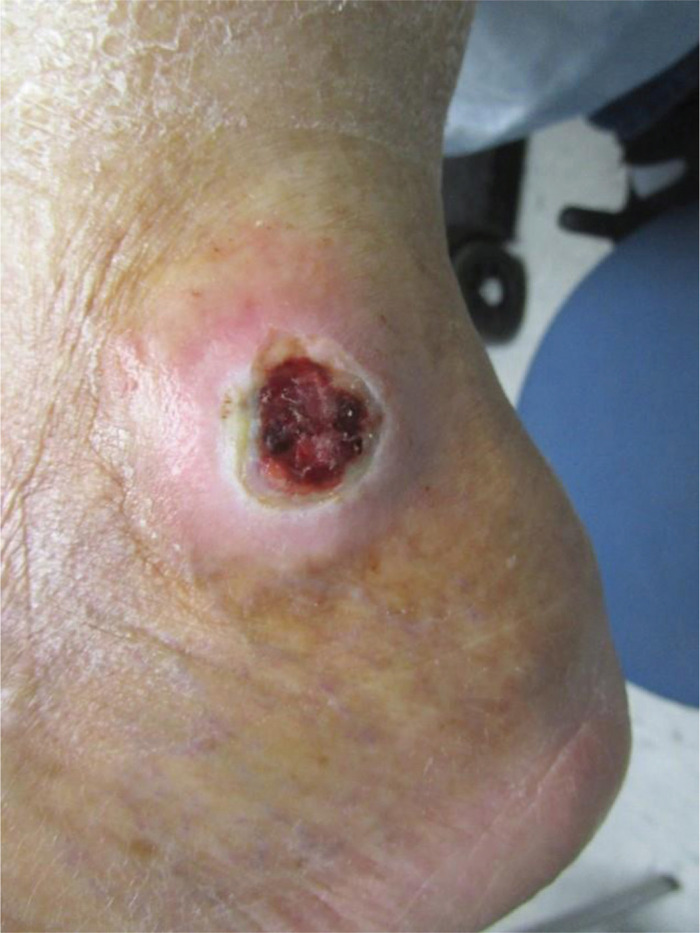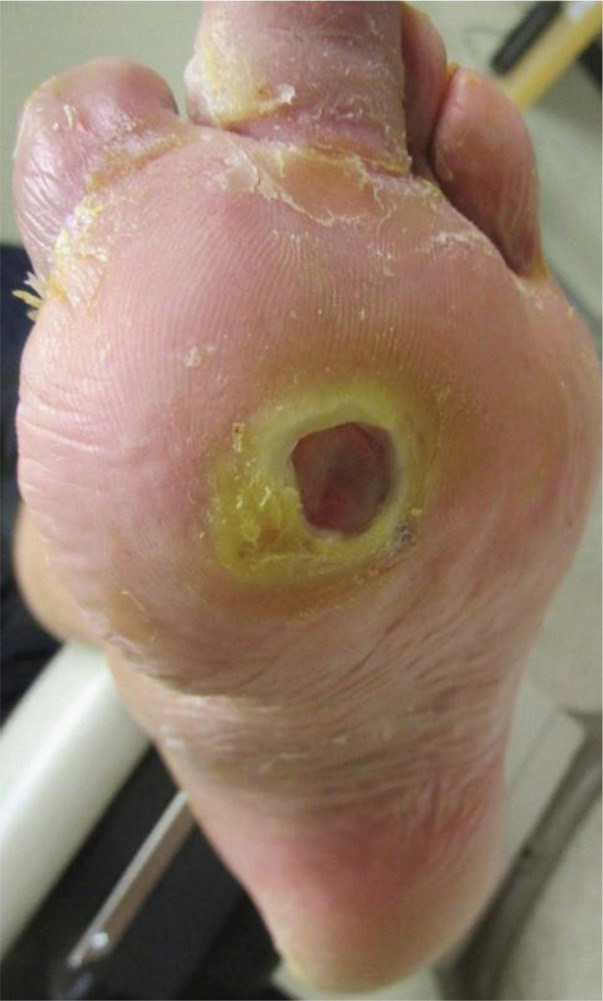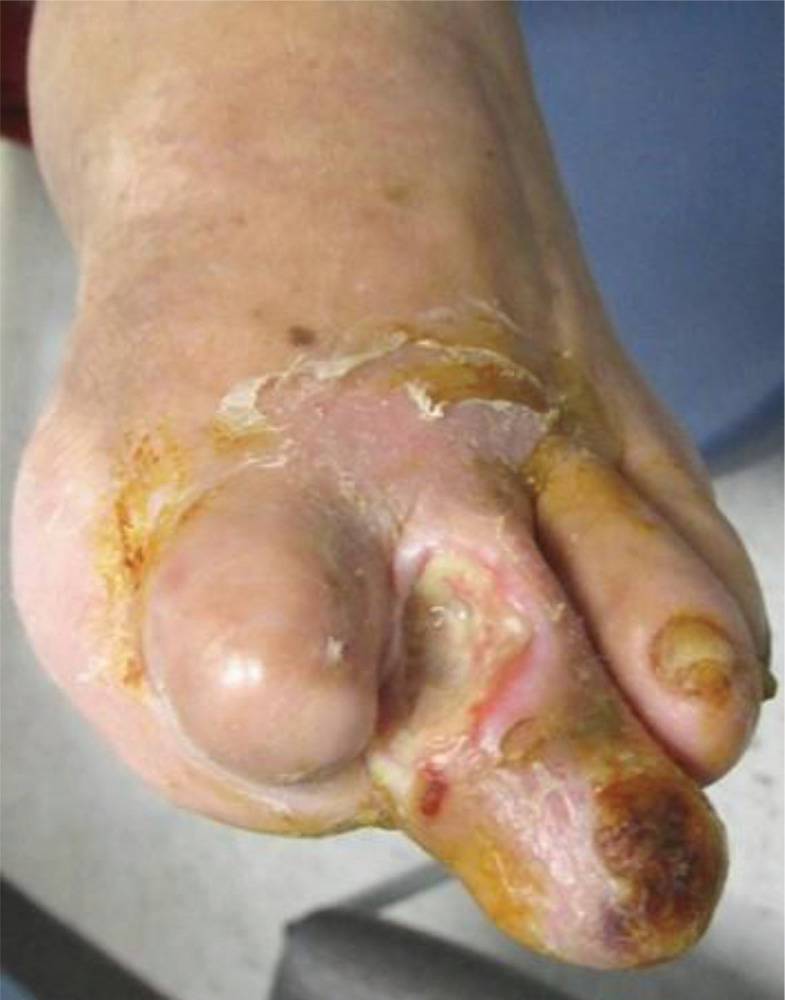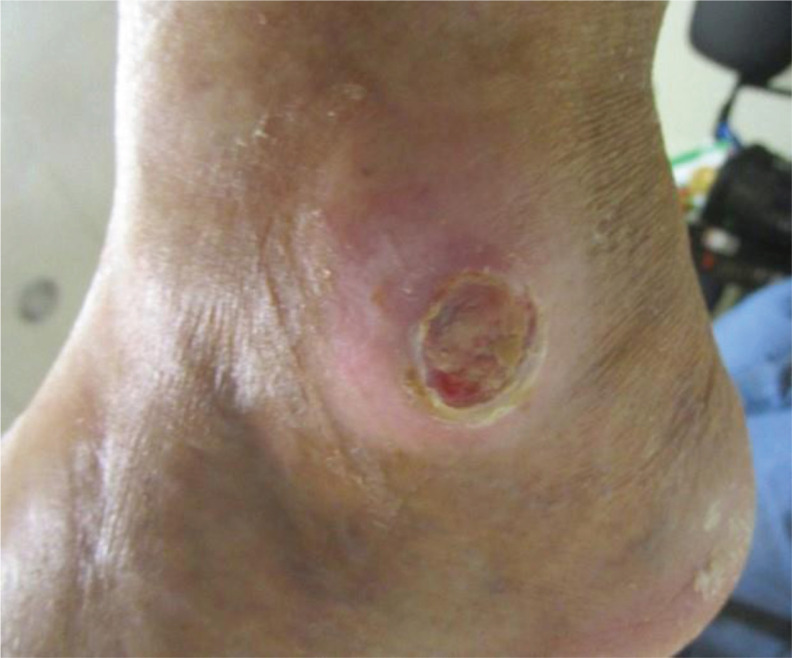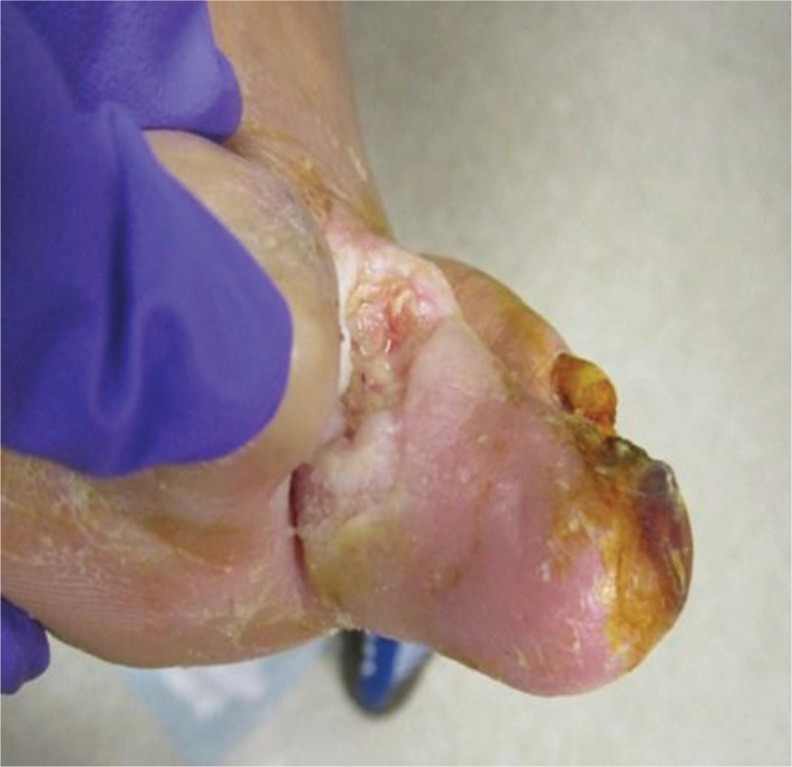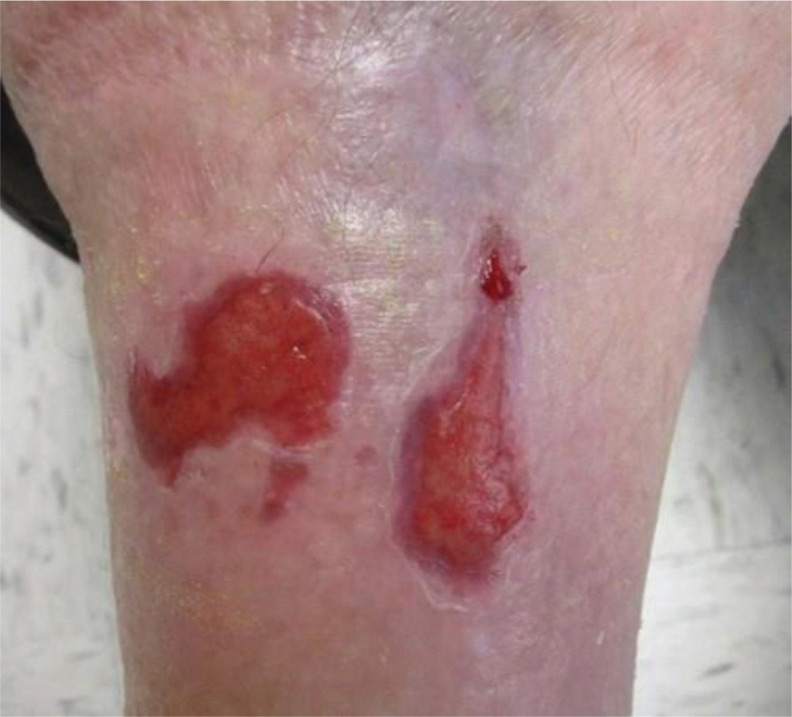BACKGROUND:
Prior to the COVID-19 pandemic, the Cardiovascular Surgery (CV) service of an academic medical center conducted a quality improvement project to decrease readmissions to the hospital from 2 rehabilitation facilities using telehealth via video calling. This initiative became of great importance with the COVID-19 pandemic because it helped the CV service better navigate and more efficiently meet the patient care needs associated with patient care restrictions. The CV service had to quickly evaluate and implement measures to reduce the rate of transmission of the coronavirus, which included adapting the clinic workflow to comply with state and federal recommendations. To minimize the interruption of clinical services and the associated revenue, a rapid transition from outpatient clinic visits to telehealth visits was implemented.
CASES:
Two cases reports of patients with wounds managed with 2 different telehealth platforms are described. Doxy.me platform allows the provider to e-mail or text a link to their personal waiting room for patients to join the video call. The second platform is Cisco Jabber platform to connect directly to the nursing unit at a skilled nursing or rehabilitation facility.
CONCLUSION:
Health care systems have had to adjust the manner in which they triage, evaluate, and care for patients using telehealth platforms that do not rely on in-person clinic visits during the COVID-19 pandemic. There are multiple telehealth platforms that require careful planning and treatment implementation. Each health care agency needs to choose the one or ones that function the best in their care setting.
Keywords: COVID-19, Hospital readmissions, Professional remote visits, Telehealth, Telemedicine, Televideo, Video calls, Wounds
INTRODUCTION
Care transitions occur when a patient moves from one health care provider or setting to another. Nearly 1 in 5 Medicare patients discharged from a hospital—approximately 2.6 million seniors—are readmitted within 30 days, resulting in annual costs of $26 billion.1 There are multiple factors along the continuum of care that impact hospital readmissions; identifying the key drivers of readmissions and their downstream providers is a first step toward implementing the appropriate interventions necessary for reducing readmissions.
Prior to the COVID-19 pandemic, the Cardiovascular Surgery (CV) service of an academic medical center conducted a quality improvement project from 2018 to 2019 to decrease readmissions using video calling. The initiative became of greater importance with the COVID-19 pandemic, which helped the CV service better navigate and more efficiently meet the patient care needs associated with new patient care restrictions.
Specifically, the CV service at our hospital identified 2 high-volume rehabilitation facilities to which patients were discharged in 2018 (56% of all CV patients) and 2019 (37% of all CV patients). During our study period between August 2018 and September 2019, 144 patients were discharged to these facilities. In our study, the control group (n = 77) received standard care, which involved a clinic nurse telephone calling the rehabilitation nurse to follow up on the patient recently discharged from the hospital. In the intervention group (n = 67), video calls using a Cisco Jabber platform on a Computer Workstation On Wheels (WOW) was set up to connect directly to the nursing unit at the skilled nursing or rehabilitation facility with the touch of a button without using smartphones, links, or Internet to enhance communication between the clinic nurse and the rehabilitation nurse. Patients were also included in these video calls. The clinic nurse used a set of standardized questions for both groups during these calls that occurred within 48 hours of hospital discharge. The goal was to enhance continuity of care and reduce readmissions. If patients had wounds, the wound, ostomy, and continence nurse practitioner (NP) was included in the video call to the facility. All calls were documented in the electronic medical record (EMR) and stored in a secure access database.
Results from the study showed that readmission rates were 50% (n = 11 patients) less from the rehabilitation facility where video calling was utilized and included the patient compared to the rehabilitation facility that communicated only by telephone and excluded patients. Patients included on the video calls expressed appreciation for being included as part of the process for continuity of care between the hospital and the rehabilitation centers. Patient demographics were compared and found to be similar for both groups.
With COVID-19, the institution quickly had to look at measures to reduce the rate of transmission of the coronavirus, which included adapting the clinic workflow to comply with state and national recommendations and led to unprecedented changes in the way health care was delivered at our health care system. These changes included suspension of elective procedures and postponing nonessential, in-person clinic encounters. Health care providers such as WOC nurses who principally relied on in-person encounters were forced to find alternative ways to provide care while adhering to the restrictions. To minimize the interruption of clinical services and the associated revenue, a rapid transition from outpatient clinic visits to telehealth encounters was implemented. Major considerations related to telehealth included choosing which telehealth platforms to use to provide care and which patients and providers could participate via telehealth. We also considered appropriate devices that would allow for the best connectivity with the patient and the provider, made sure patients resided in a state that allowed these services to be billed, and determined how to screen patients for those with the most urgent needs.
Physical and environmental factors related to telehealth included updating tablet devices in the clinic. Monitors with cameras and microphones were also installed in clinic examination rooms. The professional remote visit type was created. Smart phrases (dot phrases) were developed to insert predefined, modifiable data or text into clinic notes in the EMR. These phrases help create standard work and save time. The telemedicine video smart phrases includes verbal consent for visit, state of residency, consent for a possible insurance copay, reason for the visit, history of present illness (HPI), review of systems (ROS) with the assessment, and treatment plan discussed with the patient or significant other.
The Doxy.me platform was chosen over other telehealth platforms for patients because it was easy to use, secure, Health Insurance Portability and Accountability Act (HIPAA)-compliant, and accessible from desktop computers, tablet devices, and smartphones. On the day of the telehealth appointments, patients were sent a text message or e-mail containing the clinic room link to log on to the site and then communicate with the provider.
CASE 1
Mr H. is 66 years old with a past medical history of hypertension, hyperlipidemia, coronary artery disease status post–coronary artery bypass graft surgery, stage 3 chronic kidney disease, and type 2 diabetes mellitus with peripheral neuropathy. He was originally referred by a local wound care clinic for wound care recommendations for left foot wounds that had been present for over a year.
At the initial clinic visit, a comprehensive foot exam was performed on both feet. He had loss of protective sensation of both feet, sensory ataxia, and a history of falls. He had yellow thickened toenails suggestive of onychomycosis and previous amputations of the left first and second toes. The skin on his feet and lower legs was dry and flaky. He had +1 palpable pedal pulses bilaterally. His feet were warm to touch and trace edema in the legs and feet was present. He had a history of a left leg stent placed in the anterior and posterior tibial arteries. On his initial visit to the clinic, he had a stage 3 pressure injury on the left lateral malleolus wound, which his wife attributed to him sleeping on his side; the injury measured 1.5 × 1.5 × 0.5 cm with dark red granulation tissue. The wound had scant serosanguinous drainage. There were no overt signs of infection or cellulitis. In addition, there was a grade 1 left plantar foot wound per the Wagner classification system, which had started as a blister and then progressed to a full-thickness ulcer that measured 2.5 × 2.5 × 0.5 cm with moderate serosanguinous drainage. A periwound callus was present, which was pared at the clinic appointment. There were no overt signs of infection or cellulitis. The wounds were currently being treated with mupirocin ointment. At the initial clinic appointment, mupirocin was discontinued; he was instructed to apply a silver calcium alginate dressing to the left plantar wound to better absorb the exudate and apply hydrogel to the left malleolar wound to add moisture. The wounds were to be cleansed daily including changing the dressings. He refused to wear the offloading shoe; thus, he was encouraged to offload the left foot using his knee scooter. He was given a follow-up appointment in 2 weeks for wound assessment. However, his appointment was cancelled due to the COVID-19 pandemic.
Mr H. was set up with professional remote telehealth visit via the Doxy.me platform during which time his wife removed the dressings to allow for visualization of his wounds. The clinician was able to reinforce to her how to cleanse, accurately measure the wounds with a tape measure, and correctly apply the wound dressings. With the Doxy.me platform, the clinician was able to take a picture of the wound(s) and place it into her professional remote visit note in the EMR. The left lateral malleolar wound was noted to have red granulation tissue (Figure 1). The wound measured 1 × 1 × 0.5 cm. The left plantar wound measured 2 × 1 × 0.5 cm with a red granulating wound bed with a small amount of periwound callus (Figure 2). No overt signs of infection or cellulitis were present in or around any of the wounds. There was trace edema in the left leg. No wounds or edema were present in the right leg.
Figure 1.
Malleolar wound.
Figure 2.
Plantar wound.
Two weeks later, the wife called, requesting a prescription for antibiotics because his wounds were deteriorating; he was running a fever of 101°F, complaining of pain, shortness of breath, and had a large amount of swelling in his left leg. He also developed a new left third toe wound (Figure 3). A telehealth visit was immediately set up. The wounds looked unchanged except for the new left third toe wound, which was covered with slough. His left leg was very edematous. He lived 2½ hours from our academic medical center. The clinician instructed his wife to take him to the local hospital emergency department (ED). He was admitted with sepsis with acute renal failure and hyperkalemia (potassium was 5.0 on admission to the hospital). He tested negative for COVID-19. The care he received included antibiotics and toe wound debridement. After discharge, telehealth visits with the Doxy.me platform were resumed; the wounds are decreasing in size with healthy granulation tissue noted (Figures 4–6). He has an upcoming telehealth visit scheduled in several weeks.
Figure 3.
Toe wound.
Figure 4.
Malleolar wound.
Figure 6.
Toe wound.
Figure 5.
Plantar wound.
CASE 2
Mrs V. is 68 years old with a past medical history of diastolic heart failure with fluid overload, pericardial effusion, status post pericardiocentesis, chronic obstructive pulmonary disease on 3 L of oxygen, chronic kidney disease stage 3, and left hip fracture with open reduction internal fixation complicated by a surgical site infection. She also has phlebolymphedema due to chronic venous and lymphatic insufficiency.
Currently residing at a skilled nursing facility, Mrs V. states she does not walk due to the inability to bear weight on the left leg due to pain experienced since the hip fracture. She sits most of the day in a wheelchair with her legs dependent. She is no longer able to participate in physical therapy at the facility. She was referred to the wound clinic for right lower extremity wounds from scraping the right leg on the bed. Upon assessment, there was +2 palpable pedal pulses bilaterally; pitting and nonpitting edema was present in both legs, with left leg edema greater than the right leg. Bilateral lower extremity measurements were left mid-thigh 60 cm, left mid-calf 49 cm, right mid-thigh 58 cm, and right mid-calf 37 cm. Stemmer's sign for lymphedema was positive bilaterally. She reports no relief of edema with leg elevation, compression wraps, or compression stockings. On the right calf were 2 wounds measuring 3 × 2 × 0.5 cm and 2 × 1 × 0.5 cm, which were red and granulating (Figure 7). There was scant serosanguinous drainage with no overt signs of infection/cellulitis. A hydrogel dressing was recommended for the right calf wounds to maintain a moist wound-healing environment and promote epithelialization. She agreed to a light compression bandage to the right lower extremity but not the left leg. Lymphedema pump was ordered. It was recommended that she space sitting times with being in bed with the legs elevated. The right leg wounds healed in 2 weeks.
Figure 7.
Leg wounds.
Several weeks later an urgent call was received from the facility. The patient had gained 10 pounds over night. The left leg was larger in size, erythematous with slightly increased warmth. She had pain in the leg, with new blisters on the posterior calf. A video call using Cisco Jabber with a WOW was set up with the clinic nurse, WOC NP, the patient's nurse at the facility, and the patient. The patient's leg was observed to be substantially edematous and erythematous; the circumference of the left mid-calf was 53 cm (previously 49 cm). Her vital signs were stable and she was afebrile. A venous duplex ultrasound scan was performed at the facility to rule out deep venous thrombosis that was subsequently not found; it was determined that she had cellulitis. Nonadherent dressings were recommended for the blisters and leg elevation was encouraged. The medical director of the facility ordered antibiotics for the cellulitis. A follow-up telehealth wound visit was set up for the following week. The skilled nursing facility staff and the patient expressed appreciation for prompt availability and support to manage the change in Mrs V.'s condition.
DISCUSSION
The effects of the COVID-19 pandemic have been felt far beyond those who are infected with the coronavirus. Health care systems have had to adjust the way they triage, evaluate, and care for all patients using methods that do not rely on in-person services. Telehealth services help provide necessary care to patients while minimizing the transmission risk of the coronavirus to health care personnel and patients.2 While telehealth technology and its use are not new, widespread adoption among health care providers and patients beyond using the telephone has been relatively slow. Recent policy changes during the COVID-19 pandemic have reduced barriers to telehealth access and have promoted the use of telehealth as a way to deliver health care.
The Centers for Disease Control and Prevention recommends that providers use telehealth whenever possible to protect patients and staff from COVID-19.2 Telehealth services can be used to screen patients who may have symptoms of COVID-19 and may provide the following:
Low-risk urgent care for non–COVID-19 conditions to identify those persons who may need medical consultation or assessment to make appropriate referrals.
Coaching and support for patients managing chronic health conditions.
Follow-up with patients after hospitalization to decrease readmissions.
Nonemergent care to residents in long-term care facilities.
Education and training for health care providers through peer-to-peer medical consultations (e-consults) that may not be available, particularly in rural areas.
Federal and state governments have relaxed telehealth regulations for providers during the COVID-19 pandemic. The Office of Civil Rights at the Department of Health and Human Services (agency that enforces HIPAA) issued an advisory that providers can use standard video chat applications that are available on phones and computers. The Centers for Medicare & Medicaid Services eased requirements so that providers can now bill Medicare to see new patients (previously limited to established patients) in any area of the country, in all care settings, and at the same rates as regular in-person visits.3
Setting up a telehealth program requires careful planning. Fortunately, the CV service at our academic medical center had already initiated telehealth initiatives to decrease readmission rates prior to the COVID-19 pandemic. During the pandemic, the CV service was required to cease all nonemergent surgeries; only urgent care patients or patients with surgical wound-healing complications could be seen in the clinic. Steps that the CV service implemented for setting up the telehealth program included the following:
Administrative staff called all patients with upcoming appointments to assess for the type of device they had and connectivity to telehealth. They also strongly encouraged patients to sign up with the patient's portal, MyChart, and were able to increase sign-up by about 40%.
Tablet devices were updated and new monitors with cameras and microphones were installed in 50% of clinic rooms in addition to adding a WOW.
Doxy.me platform was introduced, and the staff were trained on how to use the platform.
Professional remote visit types were created with smart phrases to standardize documentation for patient care and billing.
Clinic telehealth scheduling templates for advanced practice providers including NPs, physician assistants, and the WOC NP were developed.
With the introduction of these initiatives, overall in-person clinic visits were substantially decreased. After implementing the telehealth platforms, there were 72 patient telehealth visits the first month and 101 remote visits the second month.
Telehealth improves patient health outcomes.2 Remote access to health care services may also increase participation for those who are medically or socially vulnerable or those who do not have ready access to providers. Remote access may also help preserve the patient-provider relationship at times when an in-person visit is not practical or feasible.2 The first case report of Mr H. described the clinical scenario of a patient living at a long distance from our academic medical center who needed an urgent wound consult that was accomplished using the Doxy.me platform to visualize the wounds and make recommendations. The Doxy.me platform has worked well for a variety of patients with wounds seen by the WOC NP, especially those with immobility issues that have pressure injuries. In the second case, Mrs V., a resident of a local skilled nursing facility, the request for a consultation with the WOC NP for wound care was accomplished through a video call using a Cisco Jabber account. Participating in the video call prevented the patient from being transported to the ED to be evaluated.
Telehealth is not new to nurses, especially WOC nurses. As early as the 1970s, nurses began to formally use the telephone to interact with patients. The literature contains examples of home care agencies using digital images to assess wounds and prescribe treatments in the early 2000s. In a yearlong study conducted by Ratliff and Forch,4 9 long-term care patients with wounds were followed for a total of 21 visits using telehealth. They found an average cost savings of $650 for transporting these older, immobile patients to and from the clinic.
There is a large body of literature examining patient satisfaction with telehealth; however, these studies are limited by poor methodological quality. One pilot study was conducted by Hl and colleagues5 to evaluate the effectiveness of using telehealth to provide health care to vascular patients during the COVID-19 pandemic in China. Video calls using a messaging and a calling application (app) Wechat software was used to facilitate communication between patients and vascular surgeons. During the period from February 19, 2020, to March 16, 2020, 114 patients (69%) out of a pool of 165 patients and 2 vascular surgeons participated in the video call, resulting in 142 telehealth communications. The mean age of patients was 60 ± 15.2 years (range, 25-90 years), and 74 (65%) were male. The mean duration of the video call was 11.0 ± 8.9 minutes. All of the patients thought telehealth was a good substitute for coming to hospital, and 95% (108/114) preferred to have telehealth visits rather than postpone the clinic appointment. All the patients were satisfied or highly satisfied with the video call.
Orlando and colleagues6 conducted a systematic review to examine whether patients and their caregivers living in rural and remote areas were satisfied with telehealth videoconferencing as a mode of service delivery in managing their health. Thirty-six studies of varying study designs and quality met the inclusion criteria. The outcomes of satisfaction with telehealth were categorized into system experience, information sharing, consumer focus, and overall satisfaction. There were high levels of satisfaction across all of these dimensions; however, the studies were limited by poor methodological quality and did not specifically define how telehealth satisfaction was measured.
CONCLUSION
Currently, there are multiple telehealth platforms available; each health care agency needs to choose the one or ones that function the best in their care setting. In our large academic medical center and CV service, multiple modalities of telehealth are utilized. Patients may transmit wound photographs to their patient portal, MyChart, or to clinic smartphones. Video calls may be conducted by health care providers, with personnel from rehabilitation or skilled nursing facilities using Cisco Jabber, and through remote professional visits with videoconferencing using the Doxy.me platform to communicate with patients at home. We were able to provide care via these modalities for patients in our CV services that improved overall patient outcomes such as wound healing.
Footnotes
The authors declare no conflicts of interest.
REFERENCES
- 1.Centers for Medicare & Medicaid Services. Medicare telemedicine health care provider fact sheet. https://www.cms.gov/newsroom/fact-sheets/medicare-telemedicine-health-care-provider-fact-sheet. Published 2020. Accessed June 22, 2020.
- 2.Centers for Disease Control and Prevention. Coronavirus disease 2019 (COVID-19). https://www.cdc.gov/coronavirus/2019-ncov/hcp/telehealth.html. Published 2019. Accessed June 22, 2020.
- 3.Office for Civil Rights. Notification of enforcement discretion for telehealth. HHS.gov. https://www.hhs.gov/hipaa/for-professionals/special-topics/emergency-preparedness/notification-enforcement-discretion-telehealth/index.html. Published March 19, 2020. Accessed June 22, 2020.
- 4.Ratliff CR, Forch W. Telehealth for wound management in long-term care. Ostomy Wound Manage. 2005;51(9):40–46. [PubMed] [Google Scholar]
- 5.Hl L, Yc C, Jx H, Sw C. Pilot study using telemedicine video-consultation for vascular patients' care during the COVID-19 period. Ann Vascular Surg. 2020. doi:10.1016/j.avsg.2020.06.023. [DOI] [PMC free article] [PubMed] [Google Scholar]
- 6.Orlando JF, Beard M, Kumar S. Systematic review of patient and caregivers' satisfaction with telehealth videoconferencing as a mode of service delivery in managing patients' health. PLoS One. 2019;14(8):e0221848. doi:10.1371/journal.pone.0221848. [DOI] [PMC free article] [PubMed] [Google Scholar]



